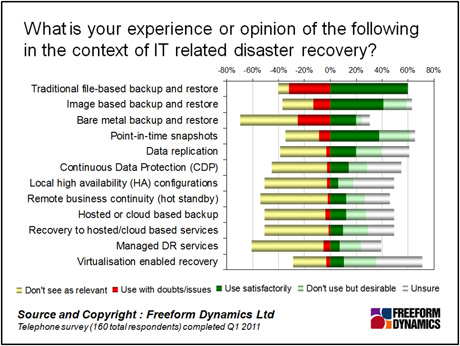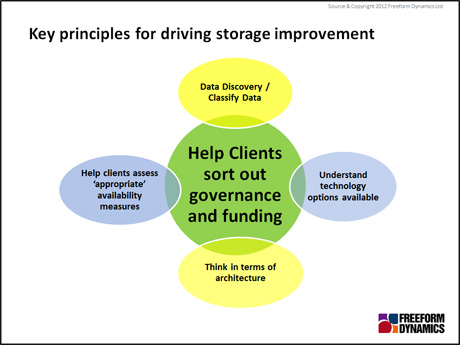Organisations of all shapes and sizes are struggling to deal with the rapid growth of data. They are expected to store it all and keep it readily available over extended periods of time, whilst IT budgets continue to come under intense scrutiny. How can the channel help their customers when they are often operating under such conflicting drivers? This article seeks to provide a few key points to use to help potential customers move their use of storage solutions forwards into the 21st century.
It is clear from a range of studies that Freeform Dynamics has undertaken over the years that many organisations, especially those without dedicated storage specialists, are far from comfortable managing their data and storage. Indeed, very few organisations have a good idea of precisely what storage systems they have in use or what data these systems hold.
This in turn is placing stress on IT managers as they seek to ensure that the company’s data assets are both properly protected and secured. Frequently such decisions are being delegated to IT with little, if any guidance, from business managers on matters concerning the security, governance and resilience that data systems should possess in order to ensure that business operations can continue safely, e.g. in the event of systems interruptions or site disaster.
The challenges are exacerbated in the majority of small and medium sized organisations because few IT professionals have good understanding, experience or perception of the modern storage solutions that may be available to help them keep the business running.
A glance at Figure 1, taken from a recent survey report, confirms that those responsible for disaster recover in SMBs largely remain focused on traditional tools and techniques. The picture we see also starkly highlights the large numbers who simply do not see many solutions as being relevant to their organisations at all.

Figure 1
Given such a widespread lack of understanding and appreciation, the challenge for the channel is clearly centred on making customers aware of the solutions that exist and helping them work out which can be of benefit to them. But in order to successfully sell any solution, there are a few key strategies that are likely to prove effective in helping get attention and solidify opportunities.
Helping customers to recognise which technology options are available to them, along with their costs and requirements for daily management, is becoming important as the packing and pricing of solutions previously only viable for large enterprises makes such systems suited to many organisations in the SMB space. But a far more decisive factor in many sales processes will be to ensure IT decision makers can communicate the business benefits their end users can expect from the solutions.

Figure 2
Figure 2 summarises the major principles to help customers get a handle on managing storage today. As mentioned earlier, few organisations have instigated effective data governance processes, a matter that is often anecdotally linked with the tricky questions of data ownership and responsibility. In addition, increasing external demands, including regulatory / legislative directives along with changing customer and shareholder expectations, to secure certain types of data coupled with the apparently unending desire of organisations to retain ever expanding volumes of data is bringing data governance to the fore.
There are a number of entry points for the channel, starting most notably with the fact that most organisations have no firm idea of the data they hold, its importance and hence the service performance, availability and security with which it should be held. Hence there is scope for data discovery and classification services to be sold. From here the path leads logically through designing storage solutions at an architectural level rather than as a series of point solutions. Recognition is growing that just adding more storage cannot carry on much longer as the management overhead and risks become too heavy to bear.
The channel can then help customers implement solutions that will be manageable over extended periods of time, but with data growth and security major factors it is essential that sophisticated technologies, such as deduplication, compression, archiving and encryption etc. be evaluated. But to clinch sales, channel partners will need to explain the business benefits delivered by such approaches, not just talk about the technologies themselves.
Channel partners have huge scope to help customers develop storage management solutions able to cater for their expanding demands, but must learn to communicate business advantages in addition to technology solutions if budgets are to be found. More importantly, channel partners have an opportunity to help their customers address other, fundamental, matters. These will require them to get even closer to how the customer functions and will probably require them to deliver considerable services as part of any solutions.
CLICK HERE TO VIEW ORIGINAL PUBLISHED ON

Registration required
Tony is an IT operations guru. As an ex-IT manager with an insatiable thirst for knowledge, his extensive vendor briefing agenda makes him one of the most well informed analysts in the industry, particularly on the diversity of solutions and approaches available to tackle key operational requirements. If you are a vendor talking about a new offering, be very careful about describing it to Tony as ‘unique’, because if it isn’t, he’ll probably know.





Have You Read This?
From Barcode Scanning to Smart Data Capture
Beyond the Barcode: Smart Data Capture
The Evolving Role of Converged Infrastructure in Modern IT
Evaluating the Potential of Hyper-Converged Storage
Kubernetes as an enterprise multi-cloud enabler
A CX perspective on the Contact Centre
Automation of SAP Master Data Management
Tackling the software skills crunch